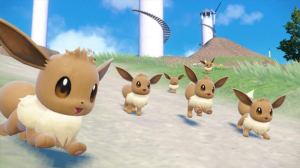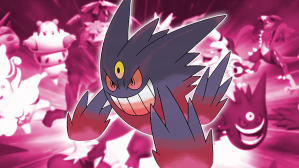There’s a pretty common misnomer that Pokemon evolution is roughly equivalent to aging. It makes sense at first glance. As a Pokemon grows more experienced (gets older), they become stronger, faster, and wiser.
Videos by ComicBook.com
Evolved Pokemon are often depicted both in canon artwork and fan art as if they were the parental types, standing over the younger un-evolved Pokemon like a parent watching their young.
Some view evolution as a kind of puberty, a time when a Pokemon’s body rapidly develops and grows. There’s also the fact that Baby Pokemon need to evolve before they can breed, another way in which evolution mimics puberty.

The connection between evolution and aging was first really explored in Pokemon Diamond and Pearl, as Professor Rowan’s main area of research was evolution. Rowan, the Pokemon Professor of the Sinnoh region, was looking into whether evolution was a way that a Pokemon reaches maturity, and if there were any behavioral differences between evolved Pokemon and Pokemon that can’t evolve (such as Legendary Pokemon).
But, despite the obvious corrolations, Pokemon evolution and aging aren’t the same thing. For one thing, we’ve seen Pokemon actively refuse to evolve in the anime. Ash’s Bulbasaur, for instance, actively refused to evolve even though it’s one of Ash’s oldest and most experienced Pokemon.
Many evolutions also require an external trigger of some kind, some of which aren’t available in their natural habitat. While it’s plausible that there are different “kinds” of evolution, it quickly becomes obvious that aging and evolution aren’t the same thing in the Pokemon universe.
So the next question becomes “Do Pokemon physically age?” Thanks to the presence of Pokemon gravesites in the Kanto, Hoenn, and Kalos regions, we actually have an easy answer to this. Visitors at the Kanto and Hoenn graveyards will comment on their departed Pokemon’s long life, implying that the Pokemon died of natural causes.
There’s also several references to aging Pokemon in the Pokedex. Ninetails, for instance, is said to live for a thousand years thanks to the supernatural energy in its tails. Wartortle’s tail also gradually changes colors as it grows older and it’s shell gradually grows algae on it as it ages. Wartortle’s Pokemon entry is particularly important as it indicates that there are ancient Wartortle that haven’t yet evolved into Blastoise.
The anime has also referenced Pokemon aging, although as a kid’s show it tends to handle death very delicately. Tracey’s Scyther was depicted as an elder Scyther that was forced out of its swarm after losing a fight for leadership. Tracey’s Scyther had limited stamina and often could keep up in longer fights due to its old age. It also has scruffier facial plates to show its age in comparison to other Scythers.

Perhaps the best example of an “elderly” unevolved Pokemon in the anime was a Treecko seen in the Pokemon: Advanced Generations episode “Tree’s a Crowd”. Ash found a Treecko colony led by an elderly Treecko, complete with wrinkles and a hunched back. Ash eventually caught a Treecko from that colony and evolved it into a Sceptile, indirectly showing that age and evolution aren’t necessarily connected.
So what’s the biological purpose of evolution if it’s not an aging mechanism? Well, that’s one of the great mysteries of the Pokemon universe. Perhaps it’s a biological instinct to help Pokemon survive in a world where predators can shoot lasers out of their mouths. We also don’t know if evolution somehow reverses or resets a Pokemon’s biological age. The link between aging and evolution remains one of the great mysteries of the Pokemon universe, but one we hope will get answered in either the game or anime.





